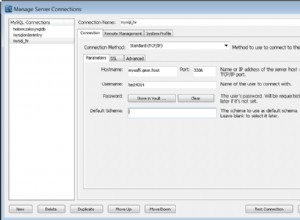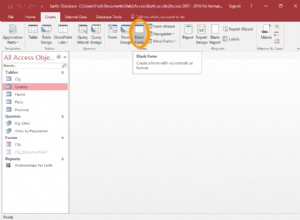Un moyen très simple pourrait être celui-ci (tandis que @x est votre plan d'exécution XML) :
DECLARE @x XML=
N'<root>
<ElementE1 AttributA1="A1-text belongs to E1[1]" OneMore="xyz">E1-Text 2</ElementE1>
<ElementE1 AttributA1="A1-text belongs to E1[2]">E1-Text 2</ElementE1>
<ElementParent>
<subElement test="sub"/>
Free text
</ElementParent>
</root>';
DECLARE @idoc INT;
EXEC sp_xml_preparedocument @idoc OUTPUT, @x;
SELECT * FROM OPENXML (@idoc, '*');
EXEC sp_xml_removedocument @idoc;
Le résultat (pas toutes les colonnes)
+----+----------+----------+--------------+------+--------------------------+
| id | parentid | nodetype | localname | prev | text |
+----+----------+----------+--------------+------+--------------------------+
| 0 | NULL | 1 | root | NULL | NULL |
+----+----------+----------+--------------+------+--------------------------+
| 2 | 0 | 1 | ElementE1 | NULL | NULL |
+----+----------+----------+--------------+------+--------------------------+
| 3 | 2 | 2 | AttributA1 | NULL | NULL |
+----+----------+----------+--------------+------+--------------------------+
| 13 | 3 | 3 | #text | NULL | A1-text belongs to E1[1] |
+----+----------+----------+--------------+------+--------------------------+
| 4 | 2 | 2 | OneMore | NULL | NULL |
+----+----------+----------+--------------+------+--------------------------+
| 14 | 4 | 3 | #text | NULL | xyz |
+----+----------+----------+--------------+------+--------------------------+
| 5 | 2 | 3 | #text | NULL | E1-Text 2 |
+----+----------+----------+--------------+------+--------------------------+
| 6 | 0 | 1 | ElementE1 | 2 | NULL |
+----+----------+----------+--------------+------+--------------------------+
| 7 | 6 | 2 | AttributA1 | NULL | NULL |
+----+----------+----------+--------------+------+--------------------------+
| 15 | 7 | 3 | #text | NULL | A1-text belongs to E1[2] |
+----+----------+----------+--------------+------+--------------------------+
| 8 | 6 | 3 | #text | NULL | E1-Text 2 |
+----+----------+----------+--------------+------+--------------------------+
| 9 | 0 | 1 | ElementParent| 6 | NULL |
+----+----------+----------+--------------+------+--------------------------+
| 10 | 9 | 1 | subElement | NULL | NULL |
+----+----------+----------+--------------+------+--------------------------+
| 11 | 10 | 2 | test | NULL | NULL |
+----+----------+----------+--------------+------+--------------------------+
| 16 | 11 | 3 | #text | NULL | sub |
+----+----------+----------+--------------+------+--------------------------+
| 12 | 9 | 3 | #text | 10 | Free text |
+----+----------+----------+--------------+------+--------------------------+
L'id montre clairement que l'algorithme est la largeur d'abord , il n'y a pas de id=1 (pourquoi jamais) et le nodetype permet de distinguer les éléments, les attributs et le texte (flottant). Le prev colonne pointe vers un frère dans la chaîne. Les colonnes manquantes sont liées aux espaces de noms...
L'approche avec FROM OPENXML est obsolète, mais c'est l'une des rares situations où il pourrait encore être très utile...
Vous obtenez une liste avec les ID et ParentIDs que vous pourriez interroger avec un CTE récursif... Cela dépend de ce que vous voulez en faire par la suite...




